TRY OUR NEW (FREE) IP RENEWAL COST CALCULATOR
Calculate
.avif)
Patents don’t last forever. To keep them in force, inventors and companies must pay renewal fees regularly, often for up to 20 years. Missing just one patent renewal deadline means the patent lapses permanently, and the invention falls into the public domain where competitors are free to use it without restriction.
The challenge is that patent renewals aren’t just a formality; they represent a major expense.
According to WIPO, they can account for as much as 75% of a patent’s lifetime costs. And because invoices are often packed with confusing categories and hidden charges, many IP holders managing global portfolios end up paying far more than they should.
In this guide, we will break down each cost category related to a patent renewal, and show where hidden fees usually appear. We’ll compare industry problems and explain how, in an ideal setup, optimising your patent renewal costs can make the process transparent and significantly more cost-effective for your patent portfolio.
Patent renewal costs fall into two major categories:
The critical point is that patentees must consider the total cost of a patent renewal. Often, IP renewal service providers offer lower service fees that seem attractive, but when total patent renewal costs (official + non-official) are compared, their total costs are overall higher. Without full transparency, customers end up overpaying.
Official fees are the baseline cost that every patent holder or company must pay in the local currency. They typically rise over time, but the exact rules depend on the jurisdiction. Patent offices use different systems for setting patent renewal fees, and this creates variations worldwide.
For example:
Since patent offices can adjust their official fees at any time, often on a yearly basis, keeping track of the latest schedules is essential for accurate budgeting.
You can find an updated database of official patent renewal fees in jurisdictions worldwide on our website. Filter easily by country, review renewal rules, and check direct links to patent offices alongside the official fees.
Transaction fees or bank fees are the costs of transferring official payments to patent offices. Typically, they range around €2–3 per payment.
Industry problem:
Many providers still rely on outdated, expensive international banking methods. Across large portfolios, this quickly adds up.
PatentRenewal.com’s solution:
We partner with multiple digital payment providers to secure the lowest transaction fees available and pass these savings directly to customers.
In some jurisdictions, patent offices only accept patent renewal fee payments through a local representative (local agent / local patent attorney). The actual requirement for a representative and their qualifications depend on the jurisdiction. Some jurisdictions requiring agents include Malaysia, Saudi Arabia, and Poland.
Industry problem:

PatentRenewal.com’s solution:
The service fee represents the IP renewal service provider’s cost of carrying out the patent renewal on your behalf. It covers the entire operational process required to keep your patents active without risk.
Industry problem:
Many IP owners and companies rely on law firms, but most firms outsource patent renewals to external providers (IP renewal service providers, like PatentRenewal.com). The problem is that their customers are in most cases not aware of this outsourcing.
This means customers are effectively charged twice: once to the law firm and once indirectly to the outsourced service provider. In addition, service fees are often tiered by patent annuity year or jurisdiction and buried in invoices, making them difficult to identify.
PatentRenewal.com’s solution:
We charge a flat, upfront service fee per renewal. This single fee covers everything you need:
No double charges. No surprise add-ons. Just transparent pricing and complete peace of mind.
Patent renewal fees must be paid in local currencies, meaning exchange rates come into play. Providers apply a markup to cover fluctuations.
Industry problem:
Many providers charge 5-30% markups, often hidden in invoices. Usually they apply an exchange rate that is far worse than the actual market rate, meaning customers pay significantly more than necessary.
What is more, this category is often not even broken down on the invoice, so you cannot see in numerical terms how much you are actually paying. On top of that, unused deposits are frequently kept as pure profit, leaving customers paying for money that never goes toward patent renewals.
PatentRenewal.com’s solution:
We apply only an average of 1-2% deposit to cover real currency fluctuations, and unlike most providers, we always refund the unused balance. You only pay for what is necessary, and nothing more.
Many providers in most cases highlight their service fees to appear cost-effective.
But the truth is that patent renewal costs are made up of several parts, and savings in one area can easily be offset by hidden charges in another.
This is why the only number that really matters is the total renewal cost. If you can’t see every fee clearly, it’s impossible to know whether you’re actually saving money.

At PatentRenewal.com, we emphasize the true total cost of patent renewal. Customers see every fee category clearly (official fees, transaction fees, local agent costs, service fees, and currency handling), so they can compare providers fairly and avoid hidden patent renewal fee charges.
Why do patent renewal costs increase over time?
Patent renewal fees generally increase as a patent gets older, but the rules vary widely from country to country. Some offices apply annual fee increases, others charge in intervals, and some even adjust costs based on the number of claims.
The result is the same: the longer you keep a patent, the more you pay. That’s why it’s so important to understand each jurisdiction’s rules and track costs carefully especially for patents you plan to hold for 10+ years.
What happens if I don’t pay patent renewal fees?
If renewal fees are missed, the patent lapses. Some offices allow a grace period with surcharges (e.g., EPO offers 6 months). Once this period passes, the patent rights are lost permanently.
Can I reduce my patent renewal costs?
Yes, by using transparent IP renewal providers you can see significant differences. PatentRenewal.com helps customers save up to 50% by eliminating unnecessary local agent fees, keeping service fees flat, minimizing transaction costs, and refunding unused currency deposits.
Do design and utility model renewals cost the same as patents?
Not exactly. Designs and utility models often have shorter lifespans and different renewal schedules. Costs are typically lower than patents but still accumulate over time.
Patent renewals are an unavoidable part of protecting your intellectual property, but that doesn’t mean you should be overpaying. Hidden service fees, unnecessary local agent charges, and inflated currency markups often make renewals far more expensive than they need to be.
At PatentRenewal.com, we’ve built a system that puts transparency first. With a flat renewal service fee, the lowest possible costs, our customers regularly save up to 50% compared to other providers.
Take the first step today and use our free online IP renewal cost calculator to get a transparent and optimal renewal cost calculation for your uploaded IP data or whole portfolio.
Interested in a free IP renewal consultation? Benchmark your current IP renewal setup and costs against market standards.
